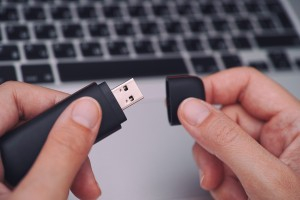
 Data Structure
Data Structure Networking
Networking RDBMS
RDBMS Operating System
Operating System Java
Java MS Excel
MS Excel iOS
iOS HTML
HTML CSS
CSS Android
Android Python
Python C Programming
C Programming C++
C++ C#
C# MongoDB
MongoDB MySQL
MySQL Javascript
Javascript PHP
PHP
- Selected Reading
- UPSC IAS Exams Notes
- Developer's Best Practices
- Questions and Answers
- Effective Resume Writing
- HR Interview Questions
- Computer Glossary
- Who is Who
How to Keep Data on a USB Flash Drive Secure
Since the dawn of humanity, we humans have been innovating and improvising the recording and storage of data. Though it may look like one of the simplest activities we humans usually practice, but storing data has been one of the most integral parts of the human existence.
This is one of the most significant advantages our race possesses over every other species that have ever traversed the blue planet. The art of storing data had empowered our ancestors to share their knowledge, experiences, art and culture with us through recording their data on paintings, sculptures, monuments and books.
Starting with simple strokes on rocks and stones, we humans have voyaged a long saga of information storage through the development of primitive and sophisticated languages, through carving sculptures and monuments, through drawings and paintings, through writing using pen and paper, to storage of information digitally.

Evolution of Technology
Optical disc devices like compact disks and optical hard drives and Solid State Devices like memory cards, Pen drives and SSDs are the most common technologies behind data storage in the present era. Technically speaking, any kind of solid state devices can be termed as a flash drive. Solid state devices, as the name suggests have no moving components. With the ease to transfer data and with greater speed, better precision, and better accuracy flash drive have been the most convenient ways of storage and transfer of data.
The main reasons behind their popularity are their compact size, huge capacity, robust build quality, reusability and cheap price. But, the main disadvantage or perhaps the only disadvantage of using flash drives is their data security. Flash drives are the most vulnerable devices when it comes to security. Harmful malware and viruses can find their way into a flash drive with just the click of a button.
Keeping Data Secure
If you are as worried about the security of your data as I was while writing this article, then below are some handy tips which you may follow in order to achieve a safe and secure data transfer and data storage experience:
Check if a device was Virus-infected
Know the security status of the computer whenever you want to connect your device to a computer. Let’s say you want to transfer some files to your flash drive from your friend’s computer. I would recommend you to inquire your friend if his/her computer has been affected by any malware or viruses recently.
Be Careful while using Public Cafes
Don’t ever recklessly connect your flash drive if the computer contains any viruses as this may affect the stored data in your flash drive in million different ways possible. If it’s an urgency, then restart the computer in the safe mode and then connect your flash drive. This will eliminate most of the dangers and risks caused by the virus unless you intentionally access the file which contains the virus. By the way, this technique is limited to Windows users only.
Maintain a Routine Scanning of Devices
Scan your flash drive for viruses from time to time. It is a wise practice to install a reliable antivirus program on your computer. Keeping the antivirus updated from time to time improves the virus detecting efficiency of your antivirus. Always keep your flash drive clean and green.
Go offline while Transferring Data

Disconnect the internet while transferring data to your flash drive. The internet is the most common source of malware and viruses. Connecting a flash drive while you are connected to the internet may sometimes result in a viral attack on the data stored in your flash drive.
Using Encrypted Drives
These flash drives have an integrated ROM which is usually 10 to 20MB in size, which contains a software that works across all operating systems. The software needs to be opened, upon which you would be required to set a password. Then after following few steps, the whole flash drive would be accessible to you. In order to access the flash drive, you will always have to enter the password, whenever you connect the flash drive to a computer.
You can also make your plug and play flash drive to work exactly as an encrypted flash drive by installing third party encryption software to your flash drive. There are tons of this software available on the internet. Once installed, the software gets integrated to your flash drive and transforms your flash drive into an encrypted drive
Conclusion
Data security has become one of the most arguably questions since the last decade. The above-mentioned tips are just some of the ways you can secure your data in a flash drive. There are much more ways to secure your data available across the internet. Feel free to use your own innovative ideas or traverse the internet for newer ways to secure your data. Your data is your asset. It is your responsibility to safeguard your assets. Never let anyone misuse your data against you.

